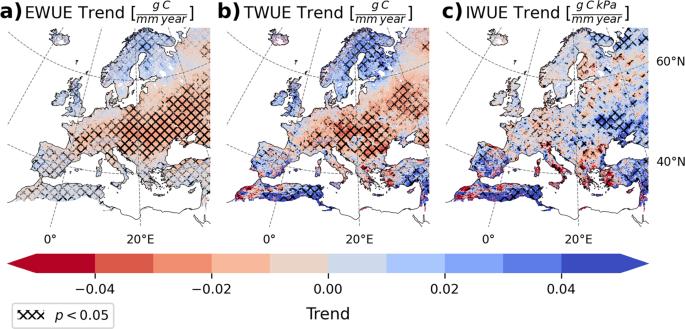初级生产力的增加推动了欧洲草原用水效率的提高
IF 8.1
1区 地球科学
Q1 ENVIRONMENTAL SCIENCES
引用次数: 3
摘要
水利用效率是生态系统每使用一滴水所吸收的碳量,是生态系统功能的一个关键指标,但人们对水利用效率随气候变化和干旱而产生的变化还不甚了解。在此,我们利用考虑到长期环境影响的遥感数据,研究了 1995-2018 年欧洲三个水利用效率指数的趋势、干旱响应和驱动因素。我们发现,中欧的固有水利用效率下降了-4.2%,生态系统功能受到威胁。在欧洲草地上,由于蒸腾作用得到调节,碳同化作用增强,固有水利用效率提高了 24.2%。此外,我们还强调了水文气候对水利用效率干旱响应的调节作用,以及适应性冠层传导对生态系统功能的重要性。我们的研究结果表明,将碳同化与树冠传导性脱钩以及高效的水管理策略可以使生态系统在气候变化的威胁和良好应对之间做出选择,并为陆地表面模型的开发提供重要启示。根据对 1995-2018 年期间遥感得出的三个指数的分析,欧洲草地通过增加总初级生产力和调节蒸腾作用提高了夏季的水利用效率本文章由计算机程序翻译,如有差异,请以英文原文为准。

Rising water-use efficiency in European grasslands is driven by increased primary production
Water-use efficiency is the amount of carbon assimilated per water used by an ecosystem and a key indicator of ecosystem functioning, but its variability in response to climate change and droughts is not thoroughly understood. Here, we investigated trends, drought response and drivers of three water-use efficiency indices from 1995–2018 in Europe with remote sensing data that considered long-term environmental effects. We show that inherent water-use efficiency decreased by −4.2% in Central Europe, exhibiting threatened ecosystem functioning. In European grasslands it increased by +24.2%, by regulated transpiration and increased carbon assimilation. Further, we highlight modulation of water-use efficiency drought response by hydro-climate and the importance of adaptive canopy conductance on ecosystem function. Our results imply that decoupling carbon assimilation from canopy conductance and efficient water management strategies could make the difference between threatened and well-coping ecosystems with ongoing climate change, and provide important insights for land surface model development. European grasslands increase their water-use efficiency in summer through increased gross primary production and regulated transpiration, according to an analysis of three indices derived from remote sensing over the period 1995-2018
求助全文
通过发布文献求助,成功后即可免费获取论文全文。
去求助
来源期刊

Communications Earth & Environment
Earth and Planetary Sciences-General Earth and Planetary Sciences
CiteScore
8.60
自引率
2.50%
发文量
269
审稿时长
26 weeks
期刊介绍:
Communications Earth & Environment is an open access journal from Nature Portfolio publishing high-quality research, reviews and commentary in all areas of the Earth, environmental and planetary sciences. Research papers published by the journal represent significant advances that bring new insight to a specialized area in Earth science, planetary science or environmental science.
Communications Earth & Environment has a 2-year impact factor of 7.9 (2022 Journal Citation Reports®). Articles published in the journal in 2022 were downloaded 1,412,858 times. Median time from submission to the first editorial decision is 8 days.
 求助内容:
求助内容: 应助结果提醒方式:
应助结果提醒方式:


